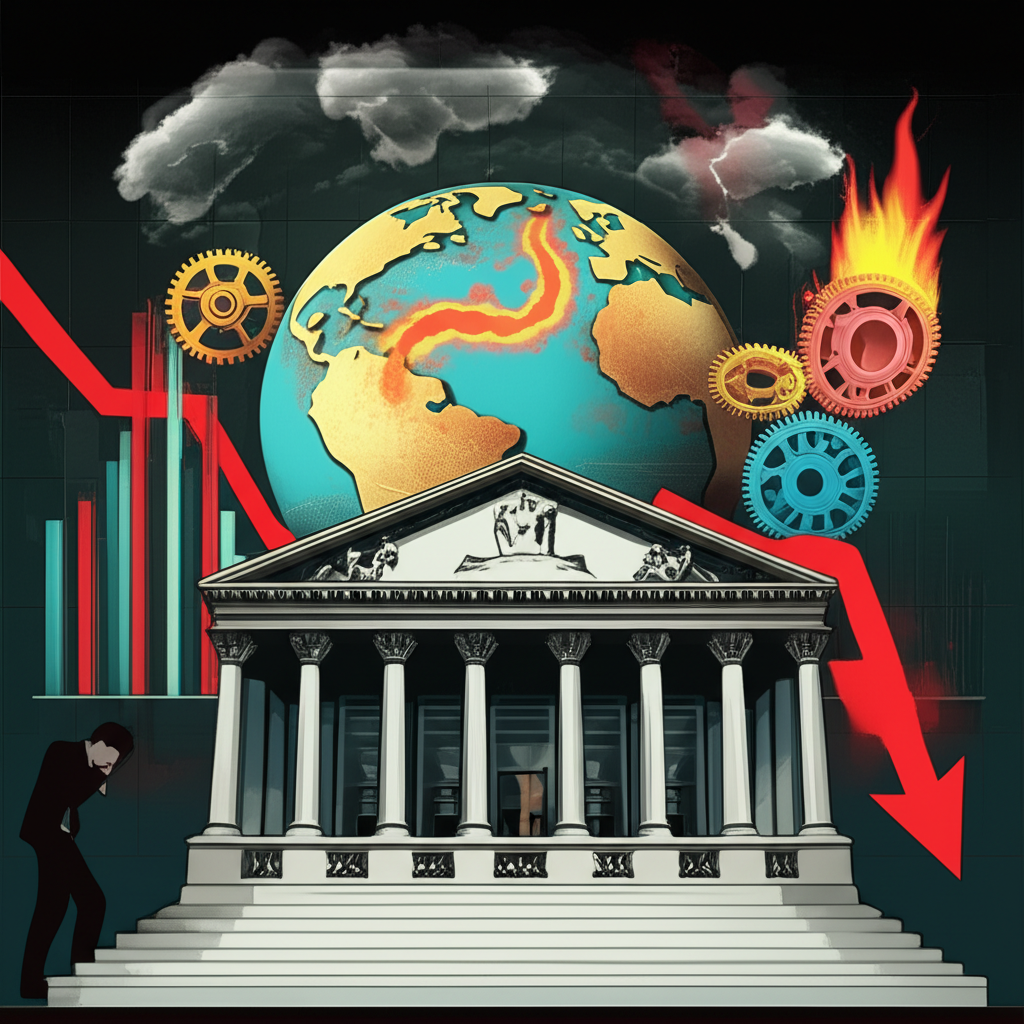
Risk-Off Sentiment: 5 Key Triggers and How to Protect Your Investments
Table of Contents
ToggleIntroduction to Risk-Off Sentiment: What It Means for Your Investments

When markets grow uneasy, investor behavior shifts in predictable yet powerful ways. One of the most consequential of these shifts is the emergence of risk-off sentiment—a phase where the appetite for risk evaporates, and the focus turns sharply toward protecting capital. During such periods, investors retreat from volatile assets like growth stocks and emerging market equities, redirecting funds into safer havens such as government bonds, gold, and stable currencies. This movement isn’t driven by short-term whims but by deeper concerns about economic instability, geopolitical tension, or tightening financial conditions. The shift reflects a fundamental change in priorities: growth takes a back seat to safety, and long-term gains are traded for immediate stability. On the flip side, risk-on sentiment describes times of confidence, when investors embrace uncertainty in pursuit of higher returns. Recognizing where the market stands on this spectrum isn’t just theoretical—it’s a practical necessity for anyone managing a portfolio in real-world conditions.
The Anatomy of Risk-Off: Core Drivers and Triggers

Risk-off episodes don’t emerge from thin air. They are reactions—sometimes swift, sometimes gradual—to developments that shake the foundation of market confidence. These catalysts often fall into three broad categories: economic strain, geopolitical upheaval, and shifts in monetary policy. Each has the power to alter investor expectations, but together, they can trigger a full-scale retreat from risk. What ties them together is a common thread: increased uncertainty. When the future becomes harder to predict, investors naturally lean toward assets with proven resilience, even if those assets offer modest returns. Understanding what sparks these shifts allows investors to anticipate changes in capital flows before they fully materialize.
Economic Uncertainty: Recessions, Inflation, and Growth Concerns
Few forces shape market psychology as directly as the health of the global economy. When growth slows, inflation spikes, or recession looms, the investment landscape changes dramatically. In such environments, corporate earnings face pressure, consumer spending weakens, and unemployment risks rise—all of which erode the fundamentals that support risk assets like equities. The 2008 financial crisis remains a textbook example: the collapse of the U.S. housing market and the subsequent implosion of financial institutions sent shockwaves through global markets, prompting a massive flight to safety. Investors fled risky assets in droves, seeking refuge in U.S. Treasuries and gold. Similarly, persistently high inflation can undermine real returns, making fixed-income securities more attractive despite low nominal yields. Even deflation—a less common but equally dangerous scenario—can trigger risk-off behavior by signaling weak demand and economic stagnation. In both cases, the market’s response is the same: a retreat from speculation and a focus on capital preservation.
Geopolitical Instability and Global Crises
Conflicts, political turmoil, trade wars, and global health emergencies introduce a different kind of uncertainty—one that’s harder to model and more emotionally charged. When war breaks out, such as Russia’s invasion of Ukraine in 2022, markets react swiftly. Energy prices spike, supply chains fracture, and the outlook for global growth darkens. In such moments, the ability to forecast corporate performance diminishes, and investors respond by reducing exposure to assets vulnerable to external shocks. The same pattern emerged during the early months of the COVID-19 pandemic, when lockdowns brought economic activity to a near standstill. The resulting market plunge wasn’t just about health concerns—it was about the sudden realization that interconnected global systems could fail in unpredictable ways. These events don’t just affect specific regions; they ripple across asset classes, reinforcing the appeal of safe-haven currencies and liquid, stable investments.
Central Bank Policies and Monetary Tightening
Few institutions wield as much influence over market sentiment as central banks. When the U.S. Federal Reserve, European Central Bank, or other major monetary authorities shift toward tighter policy—raising interest rates or shrinking their balance sheets—they alter the entire risk-reward calculus for investors. Higher interest rates increase borrowing costs, slow economic activity, and reduce the present value of future earnings, making growth stocks particularly vulnerable. At the same time, safer assets like government bonds become more appealing, especially when yields rise. The aggressive rate hike cycle launched by the Fed in 2022 to combat inflation created exactly this dynamic. As yields climbed, equities—especially technology and high-growth sectors—came under sustained pressure. The message was clear: in a higher-rate environment, the cost of taking risk increases, and investors demand stronger justification for holding volatile assets.
Risk-On vs. Risk-Off: A Fundamental Market Dichotomy

Financial markets don’t move in a straight line—they oscillate between periods of optimism and caution, expansion and contraction. At the heart of this cycle is the tension between risk-on and risk-off sentiment. This duality isn’t just academic; it shapes everything from currency valuations to bond yields to stock market performance. When confidence prevails, investors embrace leverage, chase growth, and overlook stretched valuations. When fear takes hold, the same investors scramble to reduce exposure, prioritize liquidity, and lock in safety—even at the cost of returns.
| Feature | Risk-On Sentiment | Risk-Off Sentiment |
| :——————– | :—————————————————- | :—————————————————– |
| **Investor Psychology** | Optimism, confidence, growth-seeking, fear of missing out (FOMO) | Pessimism, fear, capital preservation, uncertainty, flight to safety |
| **Economic Outlook** | Strong growth, stable inflation, low unemployment, positive corporate earnings | Slowing growth, recession fears, high inflation/deflation, geopolitical instability |
| **Asset Preferences** | Equities (growth, emerging markets), high-yield bonds, commodities (industrial), cryptocurrencies | Government bonds (e.g., US Treasuries), gold, safe-haven currencies (USD, JPY, CHF), cash |
| **Market Volatility** | Generally lower, but can see volatility in specific sectors | Generally higher, especially in equity markets (e.g., VIX Index surges) |
| **Capital Flows** | Towards higher-beta, growth-oriented assets and regions | Towards lower-beta, defensive assets and perceived safe-haven jurisdictions |
| **Currency Behavior** | Commodity currencies, higher-yielding currencies strengthen | Safe-haven currencies strengthen, emerging market currencies weaken |
This seesaw effect is a natural part of market dynamics. The key for investors isn’t to predict every shift perfectly but to recognize the signs early and adjust accordingly. A sustained move into defensive sectors, a spike in volatility, or a sudden strengthening of the U.S. dollar can all signal that the market is turning cautious.
The Impact of Risk-Off Sentiment Across Asset Classes

When risk-off sentiment takes hold, its effects are felt across the entire financial spectrum. Capital doesn’t just move—it repositions in systematic ways, driven by decades of market behavior and investor psychology. Understanding how each asset class typically responds allows investors to anticipate movements and adjust their exposure before losses accumulate.
Equities: The First to Fall
Stock markets are often the first to react when sentiment sours. Among equities, growth stocks—particularly in technology and innovation-driven sectors—tend to suffer the most. These companies are valued on future earnings, which become far less certain when economic conditions deteriorate. Similarly, emerging market equities, which rely heavily on global trade and capital flows, see sharp outflows. Even established companies can struggle, especially those with high debt loads or cyclical revenue models. Defensive sectors, such as utilities, healthcare, and consumer staples, tend to hold up better due to consistent demand for their products and services. However, no corner of the equity market is entirely immune during severe risk-off episodes. The key takeaway: when volatility spikes, equity investors should expect broad-based declines, with only limited pockets of relative resilience.
Fixed Income: The Flight to Safety in Bonds
As investors seek shelter, government bonds from politically and economically stable nations become prime destinations. U.S. Treasury bonds, German Bunds, and Japanese Government Bonds (JGBs) are classic examples. These instruments are seen as low-risk, highly liquid, and backed by strong sovereigns. As demand surges, bond prices rise and yields fall—a phenomenon clearly visible during past crises. For instance, during the 2008 downturn and the 2020 pandemic shock, yields on 10-year U.S. Treasuries hit historic lows. This flight to quality benefits governments by lowering their borrowing costs, even as other parts of the bond market face stress. High-yield corporate bonds, for example, often see widening credit spreads, reflecting increased default risk and reduced investor appetite for risk.
Currencies: The Rise of Safe-Haven Fiat (USD, JPY, CHF)
Certain currencies have earned a reputation as reliable stores of value during turbulent times. The U.S. dollar stands out due to its role as the world’s primary reserve currency, the depth of its financial markets, and the global demand for dollar-denominated assets. When uncertainty rises, capital flows into USD, pushing its value higher. The Japanese yen and Swiss franc also gain strength, though for different reasons. Japan’s massive net foreign asset position means that in times of crisis, Japanese investors often repatriate funds, boosting demand for JPY. Switzerland, with its political neutrality, strong fiscal position, and robust financial system, has long been seen as a financial safe haven, making the CHF a natural choice during global turmoil. These currencies don’t just appreciate—they often do so rapidly, creating opportunities and risks for forex traders and multinational firms alike.
Commodities: Gold’s Luster and Oil’s Decline
The commodity sector splits dramatically during risk-off periods. Gold, historically a hedge against inflation and currency debasement, typically rallies. Its scarcity, lack of counterparty risk, and long-standing role as a monetary metal make it a go-to asset when trust in financial systems wavers. In contrast, industrial commodities like oil, copper, and industrial metals tend to decline. Their prices are closely tied to global economic activity, and when recession fears grow, demand projections fall. The 2020 pandemic provided a stark example: crude oil prices briefly turned negative as storage capacity ran out and demand collapsed. While gold may not always rise in every downturn—especially if the dollar strengthens aggressively—it remains one of the most reliable proxies for investor anxiety.
How to Identify and Measure Risk Sentiment: Key Indicators
Recognizing a shift in market sentiment before it fully unfolds can make a significant difference in portfolio performance. While no single indicator offers a perfect crystal ball, a combination of signals can provide a reliable read on investor psychology.
Volatility Indices (e.g., VIX)
The Cboe Volatility Index (VIX), commonly known as the “fear gauge,” is one of the most immediate barometers of market stress. It reflects the market’s expectation of 30-day volatility in the S&P 500, derived from options pricing. When the VIX spikes—jumping from below 20 to over 40 or even 60—it signals rising fear and a shift toward risk-off behavior. The inverse is also true: a low, stable VIX often coincides with complacency and risk-on conditions. While the VIX is U.S.-centric, similar indices exist for other markets, offering a broader view of global sentiment.
Bond Yields and Spreads
The bond market often telegraphs risk sentiment before equities fully react. A falling yield on long-term government bonds—especially in the absence of inflation—suggests growing demand for safety. An inverted yield curve, where short-term rates exceed long-term rates, has historically preceded recessions and is closely watched as a warning sign. Equally important are credit spreads. When the gap between corporate bond yields and government bond yields widens, it indicates that investors are demanding more compensation for risk. This widening is a clear signal of deteriorating risk appetite and often precedes broader market declines.
Currency Pair Movements
Currency markets react quickly to shifts in risk sentiment. Traders monitor pairs like USD/JPY, EUR/CHF, and AUD/USD for early clues. A falling USD/JPY, for example, indicates yen strength and growing risk aversion. Conversely, a rising AUD/USD may signal improving risk appetite, as the Australian dollar is sensitive to global growth and commodity demand. Emerging market currencies often weaken sharply during risk-off episodes, reflecting capital outflows and reduced investor confidence.
Market Sector Performance
Within equity markets, sector rotation can reveal underlying sentiment. Defensive sectors—utilities, consumer staples, healthcare—tend to outperform during downturns, while cyclical sectors like technology, financials, and industrials lag. A sustained shift in leadership from growth to value or defensive stocks can indicate that investors are prioritizing stability. Monitoring relative strength between sectors provides a real-time view of where capital is flowing.
Navigating Risk-Off Markets: Strategies for Investors and Traders
Reacting to risk-off sentiment isn’t about panic—it’s about preparation. Investors who understand the dynamics of market cycles can position themselves to weather downturns and emerge stronger.
Portfolio Diversification and Asset Allocation
A well-structured portfolio should never be fully exposed to a single market regime. Diversification across asset classes—equities, bonds, cash, gold, and alternative investments—helps buffer against sharp drawdowns. During risk-on periods, it’s tempting to overweight growth assets, but maintaining a strategic allocation to safe-haven instruments ensures resilience when conditions change. Regular rebalancing allows investors to lock in gains from outperforming assets and reinvest in underperforming ones, maintaining a consistent risk profile over time.
Hedging Strategies (e.g., Options, Futures)
For more experienced investors, derivatives offer powerful tools for managing downside risk. Buying put options on broad market indices allows investors to profit from declines, offsetting losses in long equity positions. Futures contracts can hedge against currency, interest rate, or commodity risks. While these strategies require expertise and careful risk management, they can significantly reduce portfolio volatility during turbulent periods.
Focusing on Quality and Defensive Stocks
When uncertainty reigns, not all stocks are created equal. Companies with strong balance sheets, low debt, consistent cash flows, and reliable dividends tend to outperform. These “quality” stocks often operate in essential industries—pharmaceuticals, utilities, food production—where demand remains stable regardless of the economic cycle. While they may not deliver explosive gains, their resilience makes them valuable holdings during downturns.
Cash as a Position and Opportunity for Re-entry
Holding cash is often misunderstood as a passive or unproductive choice. In reality, it’s one of the most active decisions an investor can make. Cash provides liquidity, reduces forced selling, and creates optionality. When markets decline, having dry powder allows investors to buy high-quality assets at discounted prices. Some of the best long-term returns come not from timing the top, but from having the capital and conviction to invest at the bottom.
Risk-Off Sentiment in the Cryptocurrency Market: Unique Dynamics and Responses
Once thought to be immune to traditional market forces, the cryptocurrency market has shown increasing correlation with broader financial trends. While Bitcoin was initially promoted as “digital gold,” its price behavior during recent crises suggests otherwise. During the 2022 rate hike cycle and the early days of the pandemic, Bitcoin sold off sharply alongside tech stocks, indicating that many investors treat it as a high-beta, speculative asset rather than a safe haven.
That said, crypto has its own set of risk-off triggers. Regulatory crackdowns, exchange failures like FTX, or protocol-level vulnerabilities can spark panic within the digital asset space, independent of traditional markets. In such cases, stablecoins—particularly USD-pegged ones like USDT and USDC—often serve as internal safe havens, allowing investors to exit volatile cryptocurrencies while staying within the ecosystem.
The debate over Bitcoin’s role continues. Its fixed supply and decentralized nature make it appealing as a hedge against monetary debasement. But until its price action decouples from risk-on assets, most investors will likely continue to view it as a speculative play rather than a true store of value during crises.
Historical Case Studies: Lessons from Past Risk-Off Events
History doesn’t repeat, but it often rhymes. Examining past risk-off episodes reveals recurring patterns in investor behavior, asset performance, and policy response.
The 2008 Global Financial Crisis
**Trigger:** The collapse of the U.S. housing market, widespread mortgage defaults, and the failure of major financial institutions like Lehman Brothers.
**Market Reaction:** Global equity markets crashed, with the S&P 500 losing more than half its value. Investors rushed into U.S. Treasuries, driving yields to multi-year lows. The U.S. dollar strengthened, and gold rose as a hedge. Industrial commodities, particularly oil, plummeted on recession fears.
**Lessons:** The crisis highlighted the fragility of interconnected financial systems and the speed at which panic can spread. It affirmed the role of central banks as lenders of last resort and demonstrated the importance of liquidity and capital preservation in extreme conditions.
The COVID-19 Pandemic Shock (Early 2020)
**Trigger:** The rapid global spread of a novel virus and the unprecedented economic shutdowns that followed.
**Market Reaction:** Equities fell at one of the fastest rates in history, with the S&P 500 dropping over 30% in weeks. There was a brief “dash for cash,” pushing the U.S. dollar higher. Government bonds and gold saw strong inflows. Even Bitcoin, despite its supposed safe-haven qualities, dropped sharply before recovering. Oil prices turned negative due to demand collapse and storage issues.
**Lessons:** The episode showed how exogenous shocks can override fundamentals. It also demonstrated the power of coordinated monetary and fiscal stimulus to stabilize markets and restore confidence once the immediate crisis passed.
The 2022 Inflation and Rate Hike Cycle
**Trigger:** Persistent inflation driven by supply chain disruptions and post-pandemic demand, leading central banks to aggressively tighten policy.
**Market Reaction:** A prolonged risk-off environment emerged, with growth stocks and cryptocurrencies hit hardest. Bond yields initially rose with inflation but later fell as recession fears grew. The U.S. dollar strengthened broadly, reaching multi-decade highs. Gold was under pressure but found support as real yields stabilized.
**Lessons:** This period showed that monetary policy alone can sustain a risk-off environment, even without a full-blown crisis. It underscored the vulnerability of high-duration assets to rising rates and the importance of adjusting valuations in a higher-cost-of-capital world.
Conclusion: Adapting to Market Cycles with Informed Resilience
Risk-off sentiment is not an anomaly—it’s a recurring feature of financial markets. Driven by economic shifts, geopolitical events, and policy decisions, it reflects the natural ebb and flow of investor confidence. While these periods can be unsettling, they also reinforce core principles of sound investing: diversification, discipline, and a long-term perspective. By monitoring key indicators like the VIX, bond yields, currency movements, and sector performance, investors can detect shifts early and respond thoughtfully.
The cryptocurrency market’s behavior during recent downturns reminds us that no asset exists in a vacuum. Even the most innovative financial instruments are subject to broader market psychology. The lessons from past crises—2008, 2020, and 2022—highlight the importance of preparation, flexibility, and emotional control.
Ultimately, surviving—and thriving—during risk-off periods isn’t about avoiding downturns. It’s about building a resilient strategy that allows you to protect capital, maintain liquidity, and seize opportunities when others are forced to sell. Informed resilience, not prediction, is the key to long-term success in the ever-changing world of investing.
What does “risk-off sentiment” specifically mean in financial markets?
Risk-off sentiment refers to a market condition where investors become risk-averse and prioritize capital preservation over seeking higher returns. This leads to a shift of capital away from volatile, growth-oriented assets (like equities and certain commodities) and towards safer, more liquid assets (like government bonds, gold, and specific currencies).
What are the primary causes that trigger a risk-off environment?
Primary triggers include:
- **Economic Uncertainty:** Fears of recession, high inflation, or slowing growth.
- **Geopolitical Instability:** Wars, political unrest, trade disputes, or global pandemics.
- **Central Bank Policies:** Aggressive monetary tightening, such as interest rate hikes or quantitative tightening, which reduces market liquidity.
How do different asset classes (stocks, bonds, currencies, commodities) typically react during risk-off periods?
During risk-off periods:
- **Stocks (Equities):** Typically decline, especially growth and emerging market stocks.
- **Bonds:** Government bonds from stable economies (e.g., US Treasuries) rise in value as investors seek safety, leading to lower yields.
- **Currencies:** Safe-haven currencies like the US Dollar (USD), Japanese Yen (JPY), and Swiss Franc (CHF) tend to strengthen.
- **Commodities:** Gold typically rallies as a safe haven, while industrial commodities (like oil) often decline due to reduced demand expectations.
Is the U.S. Dollar considered a safe-haven currency during times of risk-off sentiment?
Yes, the U.S. Dollar is widely considered a premier safe-haven currency. This is primarily due to the immense size and liquidity of U.S. financial markets, its status as the world’s primary reserve currency, and the depth of its Treasury bond market, which offers a secure place for global capital during uncertainty.
What are the most reliable indicators to measure current risk sentiment in the market?
Key indicators include:
- **Volatility Indices:** Such as the VIX (Cboe Volatility Index), which surges during periods of market fear.
- **Bond Yields and Spreads:** Falling government bond yields and widening credit spreads between corporate and government bonds.
- **Currency Pair Movements:** Strengthening of safe-haven currencies (USD, JPY, CHF) against riskier ones.
- **Market Sector Performance:** Outperformance of defensive sectors (utilities, consumer staples) over cyclical sectors (tech, industrials).
How can investors adjust their portfolios to protect against or benefit from risk-off conditions?
Investors can:
- **Diversify:** Ensure a well-diversified portfolio with an allocation to safe-haven assets.
- **Hold Cash:** Maintain a cash position for liquidity and to capitalize on lower prices later.
- **Focus on Quality:** Invest in companies with strong balance sheets and stable earnings (defensive stocks).
- **Employ Hedging:** Use options or futures to protect against downside risk (for experienced investors).
Does “risk-off sentiment” affect the cryptocurrency market, and if so, how?
Yes, risk-off sentiment significantly affects the cryptocurrency market. During broad market downturns, cryptocurrencies like Bitcoin and Ethereum often correlate with traditional risk assets (e.g., tech stocks) and experience significant sell-offs. This suggests that for many investors, crypto is still viewed as a high-beta, speculative asset rather than a safe haven, making it vulnerable during flights to safety.
What is the difference between “risk-off” and “risk-on” sentiment?
The difference lies in investor psychology and asset preference:
- **Risk-Off:** Investors are fearful, prioritize capital preservation, and move into safe-haven assets.
- **Risk-On:** Investors are optimistic, seek higher returns, and invest in riskier, growth-oriented assets.
Can a risk-off period present opportunities for long-term investors?
Absolutely. While challenging, risk-off periods can create significant opportunities for long-term investors. Market downturns often lead to the undervaluation of high-quality assets. By maintaining a cash position and having a disciplined investment plan, long-term investors can acquire these assets at discounted prices, positioning themselves for substantial gains when market sentiment eventually shifts back to risk-on and recovery begins.
What historical examples best illustrate the effects of risk-off sentiment?
Prominent examples include:
- **2008 Global Financial Crisis:** Triggered by the housing market collapse, leading to widespread equity sell-offs and a flight to U.S. Treasuries and gold.
- **Early 2020 COVID-19 Pandemic:** An abrupt global economic shutdown caused rapid declines in equities and a scramble for liquidity into safe-haven currencies and bonds.
- **2022 Inflation and Rate Hike Cycle:** Sustained high inflation and aggressive central bank tightening led to prolonged de-risking, impacting growth stocks and cryptocurrencies while boosting the U.S. Dollar.
You may also like
Calendar
| 一 | 二 | 三 | 四 | 五 | 六 | 日 |
|---|---|---|---|---|---|---|
| 1 | 2 | 3 | 4 | 5 | 6 | 7 |
| 8 | 9 | 10 | 11 | 12 | 13 | 14 |
| 15 | 16 | 17 | 18 | 19 | 20 | 21 |
| 22 | 23 | 24 | 25 | 26 | 27 | 28 |
| 29 | 30 | 31 | ||||
發佈留言
很抱歉,必須登入網站才能發佈留言。